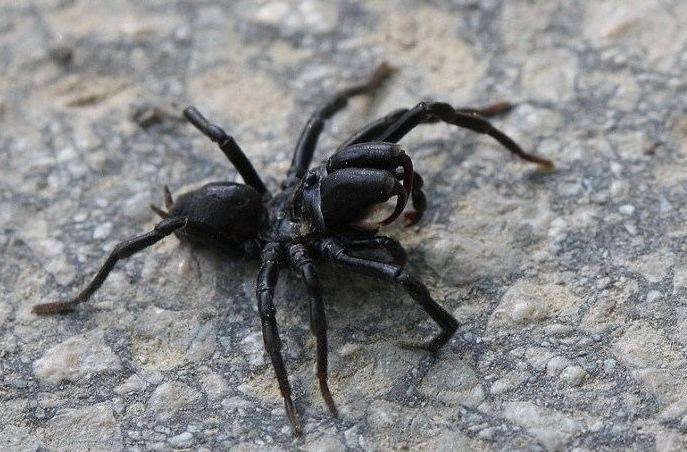Atypical tarantula
The atypical tarantulas or purseweb spiders (family Atypidae) consist of only three genera. Purseweb spiders are accomplished ambush predators that spend most of their time in a sock-like, silken retreat on the ground from where they kill their prey.
Distribution
In North America these are Sphodros and Atypus, in Asia and Africa there are Atypus and Calommata, and only Atypus in Europe.
Atypus affinis, A. muralis and A. piceus are the only species of this family found in, as well as the only mygalomorph spiders of northwestern Europe.
Biology
Atypus karschi
Atypus builds a silken tube parallel to the surface of the ground. While up to 8 cm of the tube lie on the ground, about 20 cm are buried vertically. The spider rests at the bottom of the tube. When prey walks on the exposed part, the spider, alerted by the vibrations, stabs it through the silk, cuts the web and drags it inside to be eaten. Calommata, instead of building a purse web, lives in a burrow. Sphodros usually props its tubes against a tree trunk.
Atypical tarantulas have huge chelicerae for their size and relatively long spinnerets (although not as long as those found in diplurids). The males are sometimes brightly colored and wander around looking for females in their tubes. The females are reddish-brown or dark-colored.
During the breeding season for Atypus affinis the male leaves his own burrow and goes in search of females. When he finds the burrow of a female he tentatively taps on the wall of the purse web and if the female is receptive he ventures into the confines of the burrow. The two spiders mate and they will cohabit until the male dies at which point the female eats him. The female makes an egg sac and hangs it in her burrow. It is not until the next Summer that the eggs hatch and it is not until the Spring after that the spiderlings leave their mother's burrow and wander off to find a suitable place to build a lair of their own.
Southeast Asian Atypus species have a body length of 7 to 21 mm in females, and about 12 mm in males. Calommata of this region grow from 23 to 30 mm in females, and only about 7 mm in males.
Genera
Atypus Latreille, 1804 — Britain to Ukraine, Asia, North Africa, USA (29 species)
Calommata Lucas, 1837 — Asia, Africa (7 species)
Sphodros Walckenaer, 1835 — USA, Mexico (7 species)
source - Wikipedia
if u like the post please like and shear
Because the study material is quite expensive, not all can buy it. The RBbox does the same small cache of the same information and study material to reach you for free. You also help in making this case successful by cooperating. You also have some information that you can send to others as a post or article. We will publish it with your name and picture. www.rbbox.in









No comments